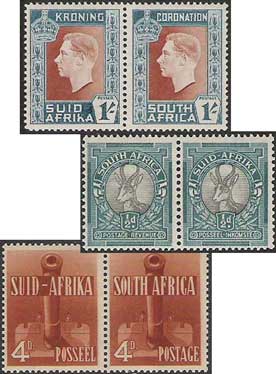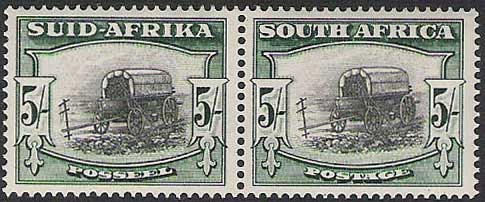|
|
|
 |
Collectors of KGVI stamps often pay little or no attention to the issues
of South Africa. Some collectors believe they are too complicated to
sort and identify, others simply don’t like the stamps, as most do not
bear the image of the King. Whatever you may think, don’t let the
prejudices of other collectors put you off. The philately of KGVI South
Africa is fascinating and very accessible. The rotogravure printing
process employed for the production of these stamps lent itself to the
unintentional creation of varieties both constant and non-constant. The
long periods for which the same basic designs were used means there are
a fantastic range of printings and shades to collect. |
There were three main groups of definitives issued during the KGVI period. They are commonly known as the
“Unhyphenated Pictorials,” the
“Hyphenated Pictorials” and the
“Screened Pictorials.”
The definitives were issued in bilingual pairs, with an English inscribed stamp and
an Afrikaans inscribed stamp alternating throughout the sheet.
The sets are so-named because the Afrikaans stamps initially had the
country name “Suidafrika” joined as one word:

Later this was changed to two words with the insertion of a hyphen, hence “Suid-Afrika”:

The last set of definitives saw the printing process changed to
include the use of a glass screen. The effect on the stamp
design was to make solid portions of colour made up of tiny dots.
This is easily visible with a magnifying glass.
 |
| |
Looking at the Stanley Gibbons catalogue you would see that the period
of issue of the unhyphenated & hyphenated definitive sets, 1930-45 & 1933-48, straddle the start of the KGVI
reign. The screened issue, 1947-54 ends when Queen Elizabeth II had been on the throne
for two years. As you can see, there is no neat or tidy start or end to the South African KGVI
period of philately, hence the KGVI collector can choose where they would like to
begin and end their collection.
|
For dedicated students of printings and shades, the bilingual stamps of
South Africa and South West Africa offer a unique collecting
opportunity. The purchase of quantities of used singles is generally
inexpensive, as these stamps are usually unwanted by collectors. The
wide use of circular date stamp postmarks means many have visible dates
to aid the ordering of issue. |
 |
 |
KGVI specialists love to collect varieties and South Africa offers
something for all budgets. A look at the Stanley Gibbons catalogue
shows a range from £5 for the 1947 Royal Tour 2d ‘Bird on 2’ variety,
through to £28,000 for the 1930/45 3d blue centre omitted, which occurs
on the September 1937 printing. There are many minor and not so minor
varieties not listed by SG, I suggest that variety hunters look for one
of the various “Union Handbook” catalogues to discover what exists.
|
We have a large section of Bantam War Effort issues (from a
specialised collection) in the single items section. Collectors of KGVI issues
love these stamps for their minor and not so minor varieties. There are
obvious ones such as the Stanley Gibbons listed ‘2/6’ flaw that occurs
on the 2d and the ‘Bursting Shell’ variety on the 1s stamp. However the
‘2/6’ flaw only occurs on the first two printings, it disappears from
later printings. Also, it can be found in both violet and red-violet
shades. The propaganda slogans urging you to buy ‘Union Loan
Certificates’ are an aid to identifying the different printings. They
occur in similar colours to the stamps, later in violet or purple,
finally they are replaced by numerals signifying the total number of
stamps in the sheet. Note the ‘Ghost’ slogans that appear in the
margins on printings of the 6d. They are especially noticeable on the
third printing.
The Official & Postage Due stamps should also be considered by the KGVI
collector. The Stanley Gibbons Part I catalogue has an excellent
listing of these issues. When deciding where to start a collection of
these note that most of the Officials of the 1930/47 (SG O12/19) issues
were in use during the KGVI period, although only the 2d blue & violet
and the 2s6d blue & brown are included in the SG KGVI printed album. As
the use of Officials ceased in January 1955, most collectors choose to
go right through to the end of their usage period. The Postage Dues do
not have a neat beginning and ending for the KGVI collector. However
most of the 1932/42 issues (SG D22/29a) would have been in use for some
part of the reign. The last set of interest would be the 1950/8
‘hyphenated’ issue (SG D39/44), minus the 4d and 1s stamps.
If you want to know more about Union of South Africa stamps read the
Introduction to the Philately of South Africa and the
Guide to the Philately of the Union of South Africa.
For further information see “The Commonwealth King George VI Catalogue”
published by Murray Payne Ltd.
“The Stamps of the Union of South Africa” by S.J Hagger, published by Reijger
Publishers Ltd. in 1986 (also known as the Union Handbook – earlier versions were published in 1946, 1952, a Volume II in 1955, combined
Volume I & II in 1960, 1979).
|
|
|






